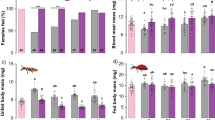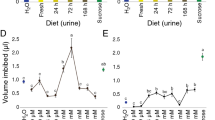Abstract
The random-mixing assumptions of many parasite-transmission models are challenged if healthy individuals can alter their behaviour to reduce their risk of infection. Some pathogens reduce the attractiveness of their hosts’ excretions, for example, potentially altering contact rates and thus the predicted force of infection for pathogens transmissible by contact with excretions. For bank voles (Myodes glareolus), contact with contaminated urine is an important route of transmission for Puumala hantavirus (PUUV); however, it is not known whether PUUV infection changes the voles’ urinary odours or their attractiveness. Here, we use a Y-maze to test whether PUUV infection alters the attractiveness of male bank voles’ urine. We presented wild-caught PUUV-free male and female bank voles with PUUV-infected conspecific urine, uninfected urine and a water control, and measured the relative and absolute latency to first visit, number of visits, and total time bank voles spent investigating each treatment over 30 min. PUUV infection significantly altered the bank voles’ initial response to conspecific urine, with fewer visits and less time spent close to infected urine relative to uninfected urine, and less total time spent near the infected urine than the uninfected urine or control. These strong preferences weakened over the 30-min trial, however, partly due to a general decline in male activity, and there were no absolute differences between the treatments overall. This suggests that PUUV infection does change the attractiveness of bank vole urine to conspecifics, and we discuss the implications of these results for random-mixing assumptions.



Similar content being viewed by others
References
Abolins SR, Pocock MJ, Hafalla JC, Riley EM, Viney ME (2011) Measures of immune function of wild mice, Mus musculus. Mol Ecol 20:881–892
Aguilar TM, Maia R, Santos ESA, Macedo RH (2007) Parasite levels in blue-black grassquits correlate with male displays but not female mate preference. Behav Ecol 19:292–301
Apio A, Plath M, Wronski T (2005) Localised defecation sites: a tactic to avoid re-infection by gastro-intestinal tract parasites in bushbuck, Tragelaphus scriptus? J Ethol 24:85–90
Arakawa H, Cruz S, Deak T (2011) From models to mechanisms: odorant communication as a key determinant of social behavior in rodents during illness-associated states. Neurosci Biobehav 35:1916–1928
Begon M, Bennett M, Bowers RG, French NP, Hazel SM, Turner J (2002) A clarification of transmission terms in host-microparasite models: numbers, densities and areas. Epidemiol Infect 129:147–153
Beltran-Bech S, Richard F-J (2014) Impact of infection on mate choice. Anim Behav 90:159–170
Bondrup-Nielson S, Karlsson F (1985) Movements and spatial patterns in populations of Clethrionomys species: a review. Ann Zool Fenn 22:385–392
Boysen P, Eide DM, Storset AK (2011) Natural killer cells in free-living Mus musculus have a primed phenotype. Mol Ecol 20:5103–5110
Carver S, Trueax J, Douglass R, Kuenzi A (2011) Delayed density-dependent prevalence of Sin Nombre virus infection in deer mice (Peromyscus maniculatus) in central and western Montana. J Wildl Dis 47:56–63
Childs JE, Glass GE, Korch GW, LeDuc JW (1989) Effects of hantaviral infection on survival, growth and fertility in wild rat (Rattus norvegicus) populations of Baltimore, Maryland. J Wildl Dis 25:469–476
Christiansen E (1980) Urinary marking in wild bank voles, Clethrionomys glareolus, in relation to season and sexual status. Behav Neural Biol 28:123–127
Dass SAH, Vasudevan A, Dutta D, Soh LJT, Sapolsky RM, Vyas A (2011) Protozoan parasite Toxoplasma gondii manipulates mate choice in rats by enhancing attractiveness of males. PLoS One 6:e27229
Dobson AP, Hudson PJ (1995) Microparasites: observed patterns in wild animal populations. In: Grenfell BT, Dobson AP (eds) Ecology of infectious diseases in natural populations. Cambridge University Press, Cambridge, pp 52–89
Escutenaire S, Chalon P, De Jaegere F, Karelle-Bui L, Mees G, Brochier B, Rozenfeld F, Pastoret PP (2002) Behavioral, physiologic, and habitat influences on the dynamics of Puumala virus infection in bank voles (Clethrionomys glareolus). Emerging Infect Dis 8:930–936
Gavrilovskaya IN, Apekina NS, Bernshtein AD, Demina VT, Okulova NM, Myasnikov YA, Chumakov MP (1990) Pathogenesis of hemorrhagic fever with renal syndrome virus infection and mode of horizontal transmission of hantavirus in bank voles. Arch Virol 1:S57–S62
Hamilton WD, Zuk M (1982) Heritable true fitness and bright birds—a role for parasites. Science 218:384–387
Hardestam J, Karlsson M, Falk KI, Olsson G, Klingstrom J, Lundkvist A (2008) Puumala hantavirus excretion kinetics in bank voles (Myodes glareolus). Emerging Infect Dis 14:1209–1215
Hart BL (1990) Behavioral adaptations to pathogens and parasites: five strategies. Neurosci Biobehav 14:273–294
Henderson D, Bird DM, Rau ME, Negro JJ (1995) Mate choice in captive American kestrels, Falco sparverius, parasitized by a nematode, Trichinella pseudospiralis. Ethology 101:112–120
Hoffmeyer I (1982) Responses of female bank voles (Clethrionomys glareolus) to dominant and subordinate conspecific males and to urine odors from dominant vs subordinate males. Behav Neural Biol 36:178–188
Hughes NK, Korpimäki E, Banks PB (2010a) The predation risks of interspecific eavesdropping: weasel-vole interactions. Oikos 119:1210–1216
Hughes NK, Price CJ, Banks PB (2010b) Predator attraction to prey olfactory signals places conspecific receivers at risk. PLoS One 5:e13114
Hughes NK, Kelley JL, Banks PB (2012) Dangerous liaisons: the predation risks of receiving social signals. Ecol Lett 15:1326–1339
Hurst JL (2009) Female recognition and assessment of males through scent. Behav Brain Res 200:295–303
Hutchings MR, Kyriazakis I, Papachristou TG, Gordon IJ, Jackson F (2000) The herbivores’ dilemma: trade-offs between nutrition and parasitism in foraging decisions. Oecologia 124:242–251
Kallio ER, Klingstrom J, Gustafsson E, Manni T, Vaheri A, Henttonen H, Vapalahti O, Lundkvist A (2006a) Prolonged survival of Puumala hantavirus outside the host: evidence for indirect transmission via the environment. J Gen Virol 87:2127–2134
Kallio ER, Poikonen A, Vaheri A, Vapalahti O, Henttonen H, Koskela E, Mappes T (2006b) Maternal antibodies postpone hantavirus infection and enhance individual breeding success. Proc R Soc Lond B 273:2771–2776
Kallio ER, Voutilainen L, Vapalahti O, Vaheri A, Henttonen H, Koskela E, Mappes T (2007) Endemic hantavirus infection impairs the winter survival of its rodent host. Ecology 88:1911–1916
Kallio-Kokko H, Laakkonen J, Rizzoli A, Tagliapietra V, Cattadori I, Perkins SE, Hudson PJ, Cristofolini A, Versini W, Vapalahti O, Vaheri A, Henttonen H (2006) Hantavirus and arenavirus antibody prevalence in rodents and humans in Trentino, Northern Italy. Epidemiol Infect 134:830–836
Kavaliers M, Colwell DD, Ossenkopp KP, Perrot-Sinal TS (1997) Altered responses to female odors in parasitized male mice: neuromodulatory mechanisms and relations to female choice. Behav Ecol Sociobiol 40:373–384
Kavaliers M, Choleris E, Pfaff DW (2005) Genes, odours and the recognition of parasitized individuals by rodents. Trends Parasitol 21:423–429
Klein SL (2003) Parasite manipulation of the proximate mechanisms that mediate social behavior in vertebrates. Physiol Behav 79:441–449
Kruczek M (1997) Male rank and female choice in the bank vole, Clethrionomys glareolus. Behav Processes 40:171–176
Mazurkiewicz M (1971) Shape, size and distribution of home ranges of Clethrionomys glareolus (Schreber, 1780). Acta Theriol 16:23–60
McCallum H, Barlow N, Hone J (2001) How should pathogen transmission be modelled? Trends Ecol Evol 16:295–300
McLennan DA, Brooks DR (1991) Parasites and sexual selection: a macroevolutionary perspective. Q Rev Biol 66:255–286
Mills JN, Schmidt K, Ellis BA, Calderon G, Enria DA, Ksiazek TG (2007a) A longitudinal study of hantavirus infection in three sympatric reservoir species in agroecosystems on the Argentine Pampa. Vector-Borne Zoonotic Dis 7:229–240
Mills SC, Grapputo A, Koskela E, Mappes T (2007b) Quantitative measure of sexual selection with respect to the operational sex ratio: a comparison of selection indices. Proc R Soc Lond B 274:143–150
Netski D, Thran BH, Jeor SS (1999) Sin Nombre virus pathogenisis in Peromyscus maniculatus. J Virol 73:585–591
Niklasson B, Hornfeldt B, Lundkvist A, Bjorsten S, LeDuc J (1995) Temporal dynamics of Puumala virus antibody prevalence in voles and of nephropathia epidemica incidence in humans. Am J Trop Med Hyg 53:134–140
Olsson GE, Leirs H, Henttonen H (2010) Hantaviruses and their hosts in Europe: reservoirs here and there, but not everywhere? Vector Borne Zoonotic Dis 10:549–561
Penn D, Potts WK (1998) Chemical signals and parasite-mediated sexual selection. Trends Ecol Evol 13:391–396
Rozenfeld FM, Denoel A (1994) Chemical signals involved in spacing behavior of breeding female bank voles (Clethrionomys glareolus Schreber-1780, Microtidae, Rodentia). J Chem Ecol 20:803–813
Rozenfeld FM, Le Boulange E, Rasmont R (1987) Urine marking by male bank voles (Clethrionomys glareolus Schreber, 1780; Microtidae, Rodentia) in relation to their social rank. Can J Zool 65:2594–2601
Sauvage F, Langlais M, Yoccoz NG, Pontier D (2003) Modelling hantavirus in fluctuating populations of bank voles: the role of indirect transmission on virus persistence. J Anim Ecol 72:1–13
Telfer S, Birtles R, Bennett M, Lambin X, Paterson S, Begon M (2008) Parasite interactions in natural populations: insights from longitudinal data. Parasitology 135:767–781
Tersago K, Schreurs A, Linard C, Verhagen R, Van Dongen S, Leirs H (2008) Population, environmental, and community effects on local bank vole (Myodes glareolus) Puumala virus infection in an area with low human incidence. Vector Borne Zoonotic Dis 8:235–244
Tersago K, Verhagen R, Leirs H (2011) Temporal variation in individual factors associated with hantavirus infection in bank voles during an epizootic: implications for Puumala virus transmission dynamics. Vector Borne Zoonotic Dis 11:715–721
Thomas F, Adamo S, Moore J (2005) Parasitic manipulation: where are we and where should we go? Behav Process 68:185–199
van der Wal R, Irvine J, Stein A, Shepherd M, Albon SD (2000) Faecal avoidance and the risk of infection by nematodes in a natural population of reindeer. Oecologia 124:19–25
Walsh PT, McCreless E, Pedersen AB (2013) Faecal avoidance and selective foraging: do wild mice have the luxury to avoid faeces? Anim Behav 86:559–566
Wyatt TD (2003) Pheromones and animal behaviour. Cambridge University Press, Cambridge
Yamazaki K, Boyse EA, Bard J, Curran M, Kim D, Ross SR, Beauchamp GK (2002) Presence of mouse mammary tumor virus specifically alters the body odor of mice. Proc Natl Acad Sci 99:5612–5615
Yanagihara R, Amyx HL, Gajdusek DC (1985) Experimental infection with Puumala virus, the etiologic agent of nephropathia epidemica, in bank voles (Clethrionomys glareolus). J Virol 55:34–38
Ylönen H, Viitala J (1991) Social overwintering and food distribution in the bank vole Clethrionomys glareolus. Ecography 14:131–137
Ylönen H, Sundell J, Tiilikainen R, Eccard JA, Horne T (2003) Weasels’ (Mustela nivalis nivalis) preference for olfactory cues of the vole (Clethrionomys glareolus). Ecology 84:1447–1452
Acknowledgments
This study was partially funded by EU grant FP7-261504 EDENext and is catalogued by the EDENext Steering Committee as EDENext212 (http://www.edenext.eu). We gratefully acknowledge the University of Antwerp for financial support (BOF-GOA project FFB3567), the Agency for Nature and Forest for permits and assistance, and Olli Vapalahti for providing IFA slides. We also thank Simon Baeckens, Indra Jacobs and Sam Puls for their assistance in the field, and Benny Borremans, Jonas Reijniers, Stefan Vandongen, Luc De Bruyn and Natalie Van Houtte for laboratory and statistical assistance. Ethical approval for this experiment was given by the University of Antwerp’s Animal Ethics Committee (approval no. 2012-14). N. K. H. is a postdoctoral research fellow with the Fonds Wetenschappelijk Onderzoek—Vlaanderen, and S. H. was supported by a University of Antwerp BOF fellowship.
Author information
Authors and Affiliations
Corresponding authors
Additional information
Communicated by Janne Sundell.
N. K. Hughes and S. Helsen contributed equally to the work.
Rights and permissions
About this article
Cite this article
Hughes, N.K., Helsen, S., Tersago, K. et al. Puumala hantavirus infection alters the odour attractiveness of its reservoir host. Oecologia 176, 955–963 (2014). https://doi.org/10.1007/s00442-014-3072-x
Received:
Accepted:
Published:
Issue Date:
DOI: https://doi.org/10.1007/s00442-014-3072-x




